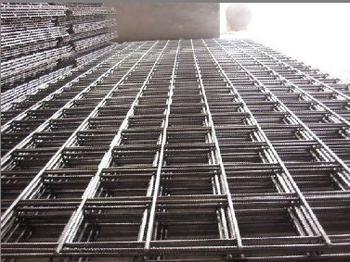钢筋绑扎要求
Requirements for steel bar binding
通常,绑扎钢筋时须依照以下要求来进行:
Usually, the binding of reinforcing bars should be carried out according to the following requirements:
(1)钢筋网片绑扎。钢筋的交叉点应选用20~22号铁丝绑扎。对于板和墙的钢筋网,除接近外围两行钢筋的相交点应悉数扎牢外,中间部分交叉点可距离交替扎牢,但有必要保证受力钢筋不发作方位偏移;在接近外围两行钢筋的相交点好按十字花扣绑扎;绑扣的方向应根据具体情况交织地改变,以免网片朝一个方向歪扭。对于面积较大的网片,可适当地用钢筋作斜向拉结加固。双向受力的钢筋须将一切相交点悉数扎牢。
(1) Reinforcement mesh binding. The crossing point of reinforcing bar should be tied with wire No. 20-22. For the reinforcing steel mesh of slab and wall, besides the intersection point of two rows of steel bars close to the periphery, the intersection point of the middle part can be secured alternately, but it is necessary to ensure that the stressed reinforcing steel bars do not suffer from azimuth deviation; the intersection point of two rows of steel bars close to the periphery should be bound by cross-stitching; the direction of the binding should be changed interlacingly according to the specific situation, so as to avoid the distorted mesh in one direction. For large meshes, reinforcement with steel bars can be properly used as oblique tension reinforcement. All intersecting points shall be firmly secured by two-way loaded steel bars.
(2)梁和柱的箍筋。对梁和柱的箍筋应与受力钢筋坚持笔直;箍筋弯钩叠合处应沿受力钢筋方向错开放置。其中梁的箍筋弯钩应放在受压区,在个别情况下,例如接连梁支座处,受压区在截面下部,要是箍筋弯钩位于下面,有可能被钢筋压“开”,这时,只好将箍筋弯钩放在受拉区(截面上部,即受力钢筋那一面),但应特别绑牢,必要时用电弧焊点焊几处。
(2) stirrups of beams and columns. The stirrups of beams and columns should be straight with the stressed steel bars, and the bending hooks of the stirrups should be staggered along the direction of the stressed steel bars. The hoop hook of the beam should be placed in the compression zone. In some cases, such as the support of the connecting beam, the compression zone is at the lower part of the section. If the hoop hook is located below, it may be "opened" by the steel bar. At this time, the hoop hook has to be placed in the tension zone (the upper part of the section, that is, the side of the stressed steel bar), but it should be tied up specially and welded with arc welding points when necessary.
(3)柱纵筋弯钩朝向。绑扎矩形柱的钢筋时,角部钢筋的弯钩平面应与模板面成45(多边形柱角部钢筋的弯钩平面应位于模板内角的平分线上;圆形柱钢筋的弯钩平面应与模板切平面笔直,即弯钩应朝向圆心);矩形柱和多边形柱的中间钢筋(即不在角部的钢筋)的弯钩平面应与模板面笔直;当选用刺进式振捣器浇筑截面很小的柱时,弯钩平面与模板面的夹角不得小于15°。

(3) The bending hook of column longitudinal reinforcement is oriented. When binding the steel bar of rectangular column, the hook plane of the corner steel bar should be 45 (the hook plane of the polygonal column corner steel bar should be located on the bisector of the inner corner of the template; the hook plane of the circular column steel bar should be straight with the tangent plane of the template, that is, the hook should be oriented towards the center of the template); the hook plane of the middle steel bar of the rectangular column and the polygonal column (that is, the steel bar not at the corner) should be straight with the template plane. The angle between the bending hook plane and the plate surface shall not be less than 15 degrees when a column with a small cross section is poured by a piercing vibrator.
(4)构件交叉点钢筋处理。在构件交叉点,例如柱与梁、梁与梁以及结构和桁架节点处杆件交汇点,钢筋纵横交织,大部分在同一方位上发作碰撞,无法装置。这种情况有必要在施工前的审图进程中就予以处理。处理办法一般是使一个方向的钢筋设置在规定的方位(按规定取保护层厚度),而另一个方向的钢筋则去避开它(常以调整保护层厚度来完成)。
(4) Reinforcement treatment at the intersection of members. At the intersection points of members, such as the intersection points of columns and beams, beams and beams, and structural and truss joints, steel bars are interwoven vertically and horizontally. Most of them collide in the same direction and cannot be installed. This situation needs to be dealt with in the process of drawing examination before construction. In general, the treatment method is to set the reinforcement in one direction in the prescribed direction (the thickness of the protective layer is taken according to the prescribed), while the reinforcement in the other direction avoids it (usually by adjusting the thickness of the protective layer).
(5)钢筋方位的固定。装置钢筋方位准确,施工时应使钢筋不出现位移,必要时预先设置相应的支架、垫块或垫筋加以固定。
(5) fixing the orientation of reinforcement. The installation has accurate orientation of reinforcing bars. The reinforcing bars should not be displaced during construction. If necessary, corresponding brackets, cushion blocks or cushion bars should be set in advance to fix them.
(6)钢筋保护层。保护层小厚度(从受力钢筋外皮算起)应符合规定,且不应小于受力钢筋的直径。传统的做法是在现场使用水泥砂浆制作出必定厚度的垫块。
(6) Reinforcement protective layer. The minimum thickness of the protective layer (calculated from the outer skin of the stressed steel bars) shall be in accordance with the regulations and shall not be less than the diameter of the stressed steel bars. The traditional method is to use cement mortar to make pads of certain thickness on site.


 咨询热线: 13605413762
咨询热线: 13605413762